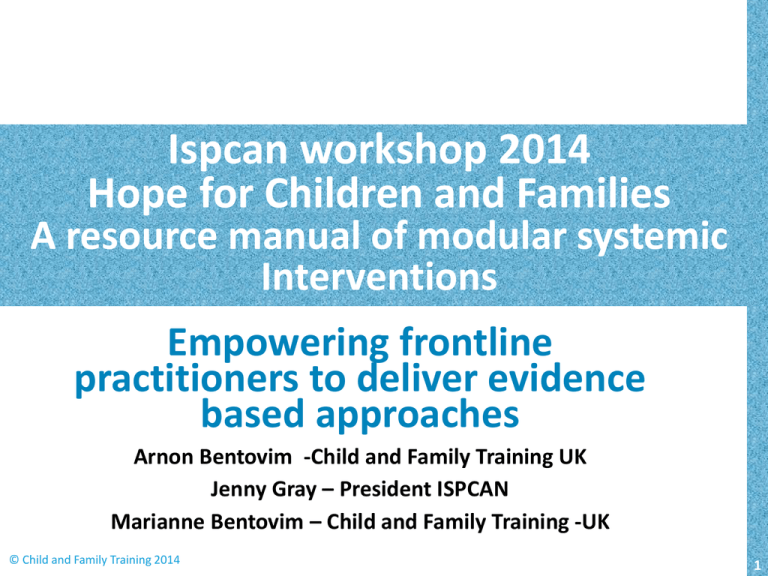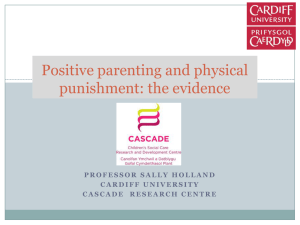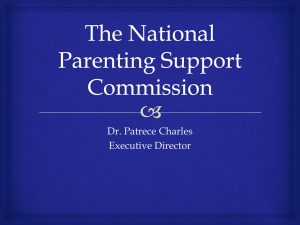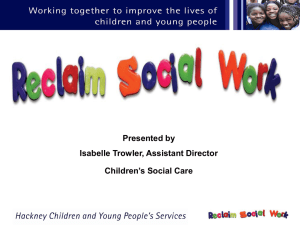
Ispcan workshop 2014
Hope for Children and Families
A resource manual of modular systemic
Interventions
Empowering frontline
practitioners to deliver evidence
based approaches
Arnon Bentovim -Child and Family Training UK
Jenny Gray – President ISPCAN
Marianne Bentovim – Child and Family Training -UK
© Child and Family Training 2014
1
What is the Hope for Children and Families
programme?
An approach to help make whole system changes to the
delivery of children’s services through adopting evidence
based approaches.
Aimed at organisations and staff working with children and
families to support and enhance the quality of direct work.
Consists of resources for assessment analysis, planning
intervention and reviewing progress.
Provides an evidence based model of practice
© Child and Family Training 2014
2
Framework
Assessment
Approaches
Analytic
frameworks
Intervention
approaches
Early help
+
+
+
Children in need
++
++
++
Contexts of child protection
+++
+++
+++
Children looked after
++
++
++
© Child and Family Training 2014
3
Seven Stages in Assessment, Analysis and Planning Interventions
Stage 1
Identification of harm and initial safeguarding
Stage 2
Making a full assessment and creating a
comprehensive chronology
Stage 3
Establishing the nature and level of harm and
harmful effects
Stage 4
Safeguarding Analysis
Stage 5
Stage 6
Child Protection Decision Making and Care
Planning
Developing a plan of intervention
Stage 7
Identifying outcomes and measures
© Child and Family Training 2013
4
© Child and Family Training 2013
5
Research background
The approach to practice is based on two
elements
“Common practice elements” that cut across
many distinct specialist treatment protocols,
specific clinical procedures and processes.
43 common elements were ‘distilled’ from 26 gold
standard research studies on ‘preventing the
recurrence of abusive and neglectful parenting,
and the impairment of children’s health and
development’ ( Chorpita and Daleiden 2009 and Bentovim and
Elliott 2014)
© Child and Family Training 2014
6
Research background
The approach to practice is based on two
elements
“ ‘Common factors’ such as the personal
and interpersonal components of all
interventions independent of approach –
systemic, CBT, or systemic:
Alliance, client motivation,
therapist/helper/practitioner relationship
issues which are significantly responsible for
effective intervention outcomes. ( Wampold
2010 )
© Child and Family Training 2014
7
Practice elements which emerged from
distillation of the research
Physical Abuse
Over 37 were identified: 15 were targeted at parents, 7
at the family and 15 at children.
Parents
Psychoeducation about the harmful impacts of abuse
Approaches to manage oppositional behaviour.
Children
Social skills training, communication skills, relaxation, personal
safety skills and problem solving.
Approaches to help children’s development, educational
support, assertiveness training and anger management.
Family interventions I
Family therapy, motivational interview to engage family and
marital and individual treatment for caregivers.
© Child and Family Training 2014
8
Practice elements which emerged from
distillation of the research
Neglect – fewer relevant studies
Practice elements which emerged focused on
facilitating professional family relationships,
engaging families,
providing a proactive management approach.
Parenting approaches
psychoeducation about the impact of severe neglect on
children’s development,
managing children’s behaviour,
promoting positive interaction, safety and good care,
helping children with personal safety skills, nutritional and
medical care.
© Child and Family Training 2014
9
Practice elements which emerged from
distillation of the research
Victims of sexual abuse
15 practice elements were targeted at children and 6 at
parents, which included:
Psycho -education about the impact of sexual abuse.
Cognitive behaviour skills in managing the exposure of
traumatic thoughts, feelings and behaviour associated with
abuse.
Relaxation skills, problem solving and relationship building.
Parents were also provided with psychoeducation, coping and
parenting skills such as providing tangible and positive
parenting skills.
© Child and Family Training 2014
10
Practice elements aimed at work with young
people responsible for harmful sexual behaviour
Young people responsible for harmful sexual behaviour.
11 practice elements were targeted at children and young
people, 6 at parents
including CBT to help children and young people manage
harmful behaviour and develop personal safety skills,
anger management, line of sight supervision.
© Child and Family Training 2014
11
Practice elements which emerged from
distillation of the research
Exposure to violence and mental health issues
The practice elements which emerged included
psychoeducation about the impact of violence or mental
health difficulties,
supporting parents to be able to listen supportively to
their children and to improve their relationship and build
rapport.
Work with children included creating a trauma narrative of
stressful traumatic events they had been exposed to, the
development of safety, skills and social skills.
© Child and Family Training 2014
12
Integration to create the HfCF resource pack
Integration into an intervention resource pack for
practitioners
A group of experienced practitioners brought all this
information together and integrated it with practice
knowledge which has developed including our own work at
Great Ormond street, the Faithfull Foundation, SWAAY, The
Maudsley
We used the UK Assessment framework as a base to
describe strengths and difficulties in Parenting, factors
which were associated with abusive parenting, and the
impact on children’s health and well being
We then organised interventions ‘around the assessment
triangle’ and made this the basis of the intervention ma
© Child and Family Training 2014
13
Assessment Framework
A map of relevant data to be collected
Health
Basic Care
Education
Ensuring Safety
Emotional &
Behavioural Development
Identity
Family & Social
Relationships
Social Presentation
CHILD
Safeguarding
&
promoting
welfare
Emotional Warmth
Stimulation
Guidance &
Boundaries
Stability
Selfcare Skills
FAMILY & ENVIRONMENTAL FACTORS
© Child and Family Training 2011
© Child and Family Training 2014
14
14
Relevant Data
© Child and Family Training 2014
15
© Child and Family Training 2014
16
© Child and Family Training 2014
17
© Child and Family Training 2014
18
© Child and Family Training 2014
19
© Child and Family Training 2014
20
© Child and Family Training 2014
21
Development of intervention approaches
‘The Hope for Children and Families Intervention Resource
Pack’
This provides an accessible set of evidence-based
approaches, resources and tools for direct work.
The resources are available in hard copy and on line
include:
Practitioner briefings – summarising theory and research,
guidance and advice for intervention.
Modules that can be linked together in a plan and programme
of work – ideas, approaches, outline for direct work sessions,
scripts, hints and tips for effective intervention.
Tools, instruments and direct work resources.
Training approaches – work books, work shops, supervision of
practice – 5 pilot sites
© Child and Family Training 2014
22
Library of modules
THEME 1 INTRODUCTION
THEME 2 INITIAL STAGES OF WORK: ENGAGEMENT AND HOPE
Engaging families, parents and children: Promoting hopefulness
Goal setting
THEME 3 WORKING WITH PARENTS: TARGETING ABUSIVE AND NEGLECTFUL
PARENTING
How abusive and neglectful parenting affects children’s development,
emotional and physical; Psychoeducation
Developing a capacity to identify and understand children’s physical and
emotional needs.
Parents coping with stress and the link with abusive and neglectful parenting
Helping parents cope with negative perceptions of children
Clarifying, sharing and reconciling the impact of abusive and neglectful
parenting
© Child and Family Training 2014
23
Library of modules 2
THEME 4 WORKING WITH PARENTS AND CARERS:
PROMOTING CHILDREN AND YOUNG PEOPLE’S
HEALTH, DEVELOPMENT AND WELL-BEING
Understanding development
Promoting Development, Early Development
Promoting Later Development
Meeting children’s and young people’s safety and
physical needs
Ensuring safety and preventing harm.
Providing good quality basic care
Nutritional care :weight faltering and failure to thrive
Shaping challenging behaviour
© Child and Family Training 2014
24
Library of modules 2
Meeting children and young people’s emotional needs
Promoting attachment, attuned responsiveness and positive
emotional relationships: Younger children.
Promoting attachment, responsiveness, positive relating
with older children: One-on-one time.
Positive parenting
Positive parenting: managing difficult behaviour
Praise
The use of attention and ignoring
Giving effective instructions
Rewards
Shaping challenging behaviour
© Child and Family Training 2014
25
Library of modules 3
THEME 5 WORKING WITH CHILDREN AND YOUNG PEOPLE
Working with emotional and traumatic responses –
-Generic modules
Developing a child-centred approach
Psycho-educational intervention on the effects of maltreatment
Safety planning
Coping skills
Relaxing and calming
Describing and monitoring feelings
Activity selection
Problem solving
© Child and Family Training 2014
26
Library of modules 3
-Problem–specific modules
Working with anxiety problems: Helping children who experience excessive anxiety
Working with mood problems: Helping children who present with persistent low
mood or with depression
Working with trauma problems: Helping children who experience traumatic
responses
Maintenance and building resilience
Working with disruptive behaviour problems of children and
young people
Enhancing children’s competence: education, talent and the ‘good life’
Developing positive relationships with family and friends
Coping with disruptive behaviour
Assertiveness training
Developing positive relationships with family and friends
© Child and Family Training 2014
27
Library of modules 4
THEME 6 WORKING WITH FAMILIES
Promoting healthy family functioning and problem solving skills
Helpful techniques to manage conflict and dysfunction in family life
Support networking for families
THEME 7 WORKING WITH PARENTS AND CARERS TO SUPPORT CHILDREN
WHO HAVE BEEN SEXUALLY ABUSED AND THOSE CHILDREN AND YOUNG
PEOPLE WHO ARE RESPONSIBLE FOR HARMFUL SEXUAL BEHAVIOUR,
Working with parents and carers to support work with children and young
people responsible for harmful sexual behaviour
Working with children under 12 who have displayed harmful sexual
behaviour
Working with adolescents (age 12+) who have displayed harmful sexual
behaviour
Promoting safety for children and young people who have been harmed
sexually in the family or by a trusted member of the community
© Child and Family Training 2014
28
Case Study: Bradshaw Family
Gina
Bradshaw
27 years
James
Smith
27 years
Ben
5 years
6 months
© Child and Family Training 2014
Frank
Thomas
29 years
Annie
2 months
29
Parenting strengths and difficulties task
Watching DVD clips of a family assessment.
Home assessment of Ben Bradshaw, aged 5 years 6
months and his parents.
Focus in particular on both parents Gina, Frank and
Ben and Annie on thoughts, feelings, responses and
consequences which resulted in potentially harmful
actions
Put yourself in the shoes of one of the 3 family
members in first clip, and Gina and Ben in the
second
How did their responses affect each other and Ben
Feed back from the perspective of each family
member ‘I felt, thought and I did!!
© Child and Family Training 2014
30
Parental/carerstress
stress
Parental/carer
Behaviour
A situation
Feelings
© Child and Family Training 2014
Thoughts
Consequences
Behaviour
31
Cycle of situations, feelings, thoughts,
behaviour and consequences
Situation
Consequences
Behaviour
© Child and Family Training 2014
Feeling
Thought
32
Feed back observations
Feed back from the perspectives of each
participant
Discussion of the interaction of these cycles
What is the risk?
© Child and Family Training 2014
33
Safeguarding analysis
During the following assessment –
An episode of inappropriate manhandling by Gina
– Gina became angry as Ben had trashed his
bedroom, she grabs him, pulls him upstairs – at
the top of the stairs he struggled to break free fell
down the stairs, Frank heard the shouting, sore
ribs, insists on taking him to the Doctor. Fractured
rib, and two old fractures on x-ray, rib and collar
bone –aged 3 and 4 –no record
Agree to Ben being placed temporarily and for
them to work with the practitioner to address
concerns© Child and Family Training 2014
34
Discuss the profile of harm
Use the diagram to note the profile of harmful
parenting, impact on Ben’s health and
development
Discussion of individual and family factors which
could account for the profile
Then look at the profile of interventions – which
would fit?
Check the library of modules
© Child and Family Training 2014
35
Future outlook for health and development
Overall prospect for successful intervention.
Ben has suffered physical, emotional harm, broken ribs.
Strengths in several areas.
Ben articulate, clear wanting his mother to stop smacking
him.
Gina blames Ben, does not understand her role.
Parents want Ben home, willing to work with professionals.
Acknowledge Ben was hurt whilst in their care – Ben
provoked, it was an accident
Gina acknowledges she needs help with Ben’s behaviour,© Child and Family Training 2014
36
Future outlook for health and development
Gina’s negative attitudes have not changed despite
move to grandparents.
Gina remains dominant, Frank not challenging.
Circular process of rejection and antagonism.
Imbalance of couple relationships continue.
© Child and Family Training 2014
37
Psychoeducation: how abusive and neglectful parenting
affects children’s development emotional and physical
Basic Principles
To address whether parents feel Ben has
been affected by harm he has experienced.
To discuss his behaviour and responses and
indicate they could be related to being
exposed to harmful experiences, even when
young.
© Child and Family Training 2014
38
Parents coping with stress and the link with
abusive and neglectful parenting
This module focuses on stress as a key factor linking with
abusive and neglectful parenting and the impairment of
children.
Using stress as a way to speak about the way stress affects
behaviour which can include abusive and neglectful
actions. A way of introducing a factor which is inherent for
all parenting and which can be modified.
Using CBT principles to manage stress and understand it is
key to this module.
© Child and Family Training 2014
39
Overview of modules - continuing
Parents coping with stress and the link with abusive and
neglectful parenting
Activity – discussing the model of stress.
Focussing on children’s temperament.
Exploring situational stressors.
Parental reaction to family of origin issues.
Managing stress.
© Child and Family Training 2014
40
Parental/carerstress
stress
Parental/carer
Behaviour
A situation
Feelings
© Child and Family Training 2014
Thoughts
Consequences
Behaviour
41
Parental reaction to family of origin issues
View the video clips of Frank and Gina’s childhood.
Discussion about how the abusive processes might be reframed in a way which could help resolution
© Child and Family Training 2014
42
Other relevant themes
Modules from other themes need to be linked together to
create an intervention that fits the needs of the particular
family. This includes choosing modules from other key
themes:
Providing good quality care and safety.
Promoting safety within the home and environment.
Promoting secure attachment, attunement and positive
emotional care.
Positive parenting
Addressing abusive and neglectful parenting,
generic interventions for children improving safety, managing
feelings, coping skills, problem solving and building resilience.
© Child and Family Training 2014
43
Building a picture of the child’s life and
building a rapport with the child
Get to know the young person- All
about me/ my galaxy/ my world/
my life as an advert/ life as a
song/ a rap
Ask them their areas of interest/
hobbies/ favourite things e.g.
animal/ food/ hobby/ TV
program/ subject at school/ time
of year/ sport etc.
Bring humour/ playfulness/ a
sense that you are really
interested in getting to know
them- what makes them tick/
what makes them sparkle?
© Child and Family Training 2014
44
Clarifying, sharing and reconciling the impact
of abusive and neglectful parenting
This is an important module which can bring together work
with parents and children individually to address abusive
and neglectful parenting.
Relieving the child of responsibility, parents taking
responsibility and developing an approach for the future
which will be safer.
© Child and Family Training 2014
45
© Child and Family Training 2013
46









